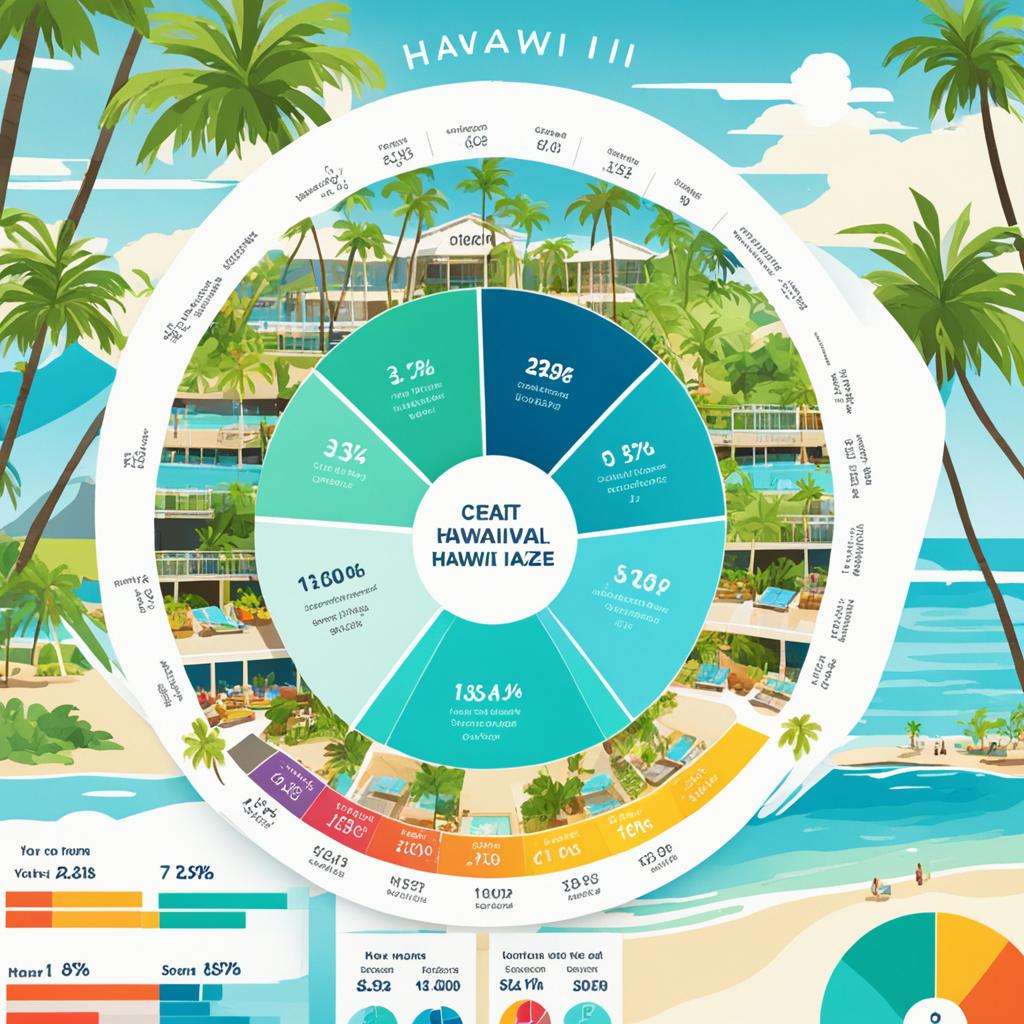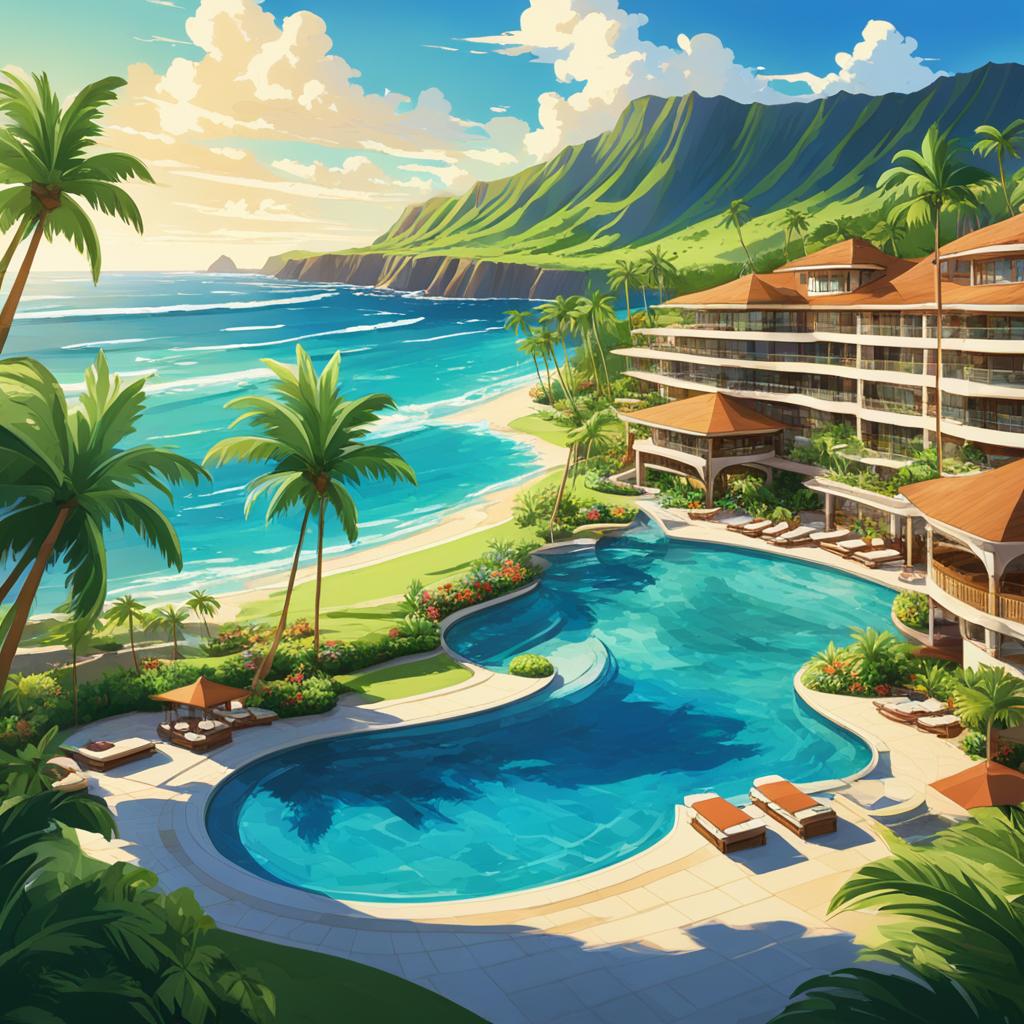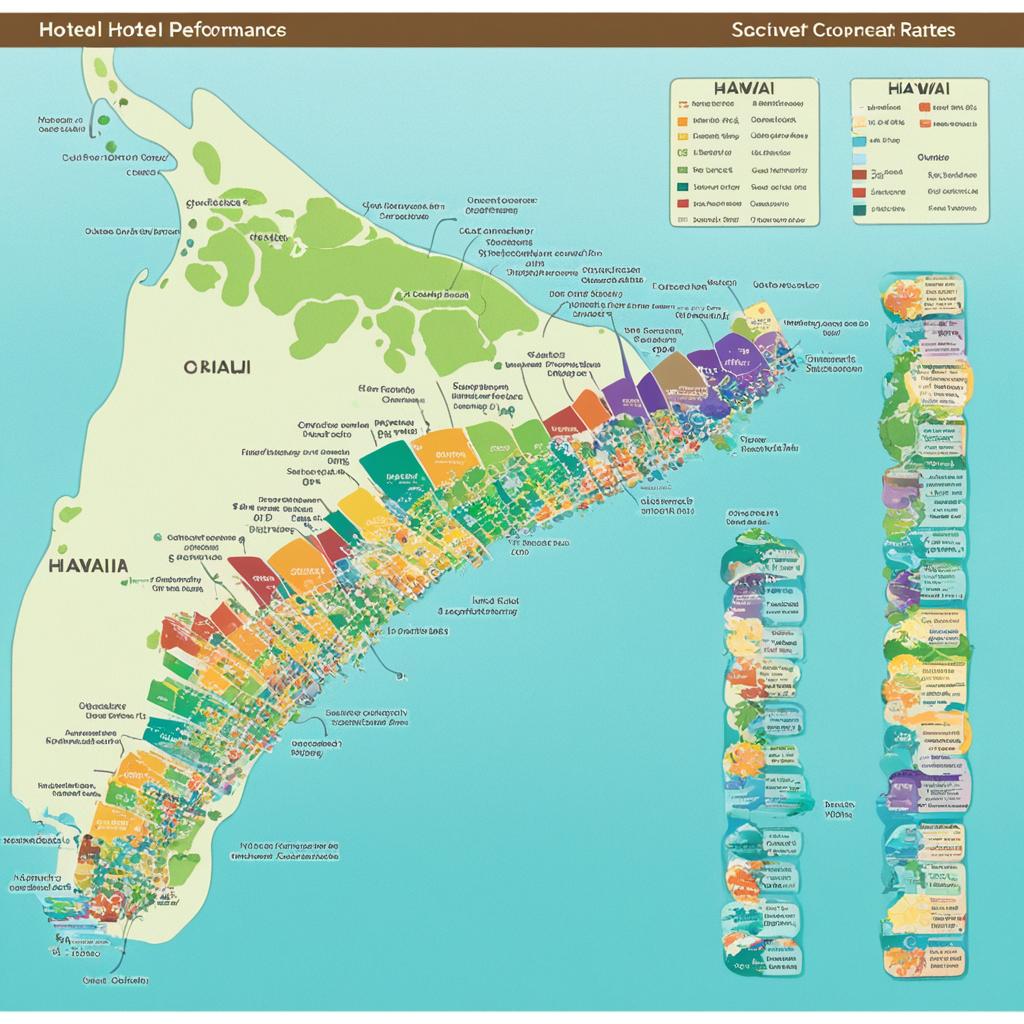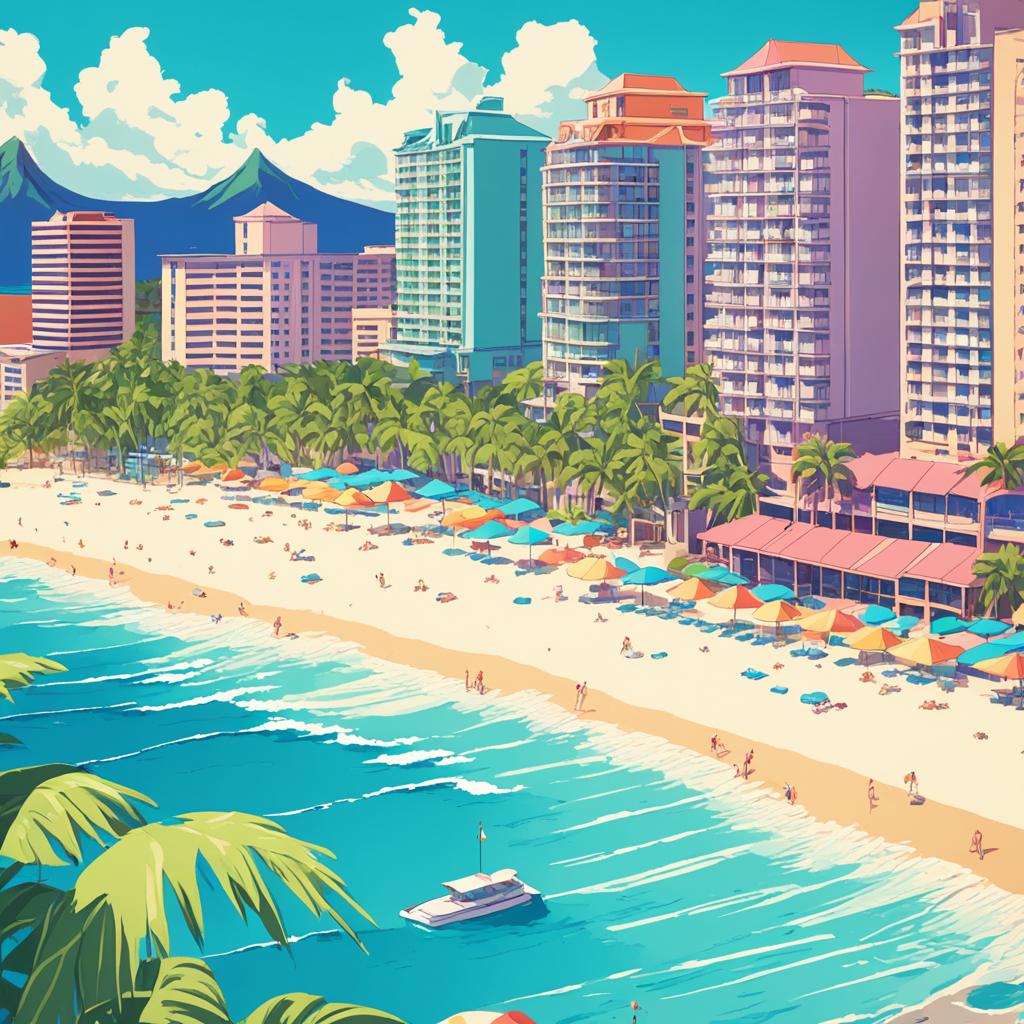When you think of Hawaii, you may envision pristine beaches, stunning landscapes, and a paradise getaway. But have you ever wondered just how many hotel rooms are available in this tropical destination? The answer may surprise you.
According to the May 2021 Hawai‘i Hotel Performance Report, there were a staggering 44,771 hotel rooms across 140 properties in Hawaii. These numbers demonstrate the immense scale of hotel accommodations in the Hawaiian Islands.
But why does Hawaii require such a vast number of hotel rooms? What drives the demand for these accommodations with visitors flocking to this beautiful state? Let’s delve deeper into the fascinating world of Hawaii’s hotel industry and explore the revenue, occupancy rates, and performance of hotels in this captivating destination.
Revenue and Occupancy Rates in Hawaii Hotels

The May 2021 Hawai‘i Hotel Performance Report revealed impressive figures, highlighting the remarkable growth in hotel revenue and occupancy rates in Hawaii. These statistics are a testament to the strong performance and increasing demand for accommodations in the Hawaiian Islands.
In May 2021, hotel room revenues statewide in Hawaii soared to $285.9 million, a remarkable increase of 1,818.3% compared to the previous year. This surge in revenue demonstrates the resilience and recovery of the hotel industry in Hawaii. The January 2022 report further reinforced this positive trend, with hotel room revenues reaching $398.7 million, a significant increase of 341.7% compared to 2021.
The occupancy rates in Hawaii hotels also experienced substantial growth during this period. In May 2021, the occupancy rate reached 61.5%, marking a remarkable 46.3 percentage point increase from the previous year. This surge in occupancy clearly signifies the increased demand for hotel accommodations in Hawaii. Similarly, in January 2022, the occupancy rate rose to 65.4%, indicating a 42.6 percentage point increase compared to the previous year.
Pandemic-induced restrictions and travel uncertainties have given way to renewed traveler confidence, resulting in an uptick in hotel bookings and a boost to the hotel industry’s performance. These positive trends in hotel revenue and occupancy rates demonstrate the resilience and appeal of Hawaii’s tourism market.
For a clearer picture of the significant growth in hotel revenue and occupancy rates, refer to the table below:
| Month/Year | Hotel Room Revenues (Statewide) | Year-Over-Year Increase | Occupancy Rate | Year-Over-Year Increase |
|---|---|---|---|---|
| May 2021 | $285.9 million | 1,818.3% | 61.5% | 46.3 percentage points |
| January 2022 | $398.7 million | 341.7% | 65.4% | 42.6 percentage points |
The table illustrates the substantial increase in hotel room revenues and the corresponding rise in occupancy rates in both May 2021 and January 2022. These statistics support the notion that the hotel industry in Hawaii is recovering and thriving.
Hotel Performance by Class and Region in Hawaii

In the May 2021 report, the performance of different hotel classes in Hawaii was highlighted. Luxury Class properties stood out with a revenue per available room (RevPAR) of $354. These hotels had an average daily rate (ADR) of $664 and an occupancy rate of 53.3%. On the other hand, Midscale & Economy Class properties had a RevPAR of $164, an ADR of $240, and an occupancy rate of 68.3%. This data demonstrates the varying performance and appeal of hotels in different price ranges in Hawaii.
Looking at the January 2022 figures, luxury hotels in Hawaii saw an increase in performance. They achieved a RevPAR of $427, with an ADR of $832 and an occupancy rate of 51.4%. On the other hand, Midscale & Economy Class hotels had a RevPAR of $217, an ADR of $281, and an impressive occupancy rate of 77.0%. These numbers indicate a positive trend for both luxury and more affordable hotels in Hawaii.
It’s worth highlighting that luxury hotels, with their higher rates and lower occupancy, cater to a specific segment of travelers who seek premium accommodations and experiences. On the other hand, Midscale & Economy Class hotels tend to attract a broader range of budget-conscious travelers.
If you’re looking for a luxurious stay in Hawaii, the state offers a wide selection of high-end establishments. From world-class resorts to boutique hotels, you’ll find options that provide exceptional amenities, impeccable service, and stunning ocean views. These luxury hotels offer an exclusive experience, ensuring your visit to Hawaii is nothing short of unforgettable.
Hotel Performance by Class in Hawaii
| Hotel Class | RevPAR | ADR | Occupancy Rate |
|---|---|---|---|
| Luxury Class | $354 | $664 | 53.3% |
| Midscale & Economy Class | $164 | $240 | 68.3% |
Hotel Performance by Region in Hawaii
Hawaii’s hotel performance also varies by region. Each area offers a unique atmosphere, attractions, and amenities for visitors to enjoy during their stay.
- The Lahaina/Kā‘anapali/Kapalua region of Maui boasts a RevPAR of $267, giving guests a taste of luxury in the charming town of Lahaina.
- Wailea, also located in Maui, offers a more exclusive experience with a higher RevPAR of $439.
- The Kohala Coast region on the island of Hawai‘i showcases a RevPAR of $300, providing a mix of natural beauty and luxury accommodations.
- In O‘ahu, Waikīkī hotels earn a RevPAR of $110, contributing to the vibrant energy of this iconic beachfront destination.
- Kaua‘i hotels, known for their stunning landscapes, earn a RevPAR of $157, allowing guests to immerse themselves in the island’s natural beauty.
These regional variations in hotel performance give travelers a range of options to choose from based on their preferences and desired experiences.
Hotel Performance by County in Hawaii

The performance of hotels in different counties in Hawaii can provide valuable insights into the hotel market in the state. The May 2021 report showcased the revenue per available room (RevPAR) for various counties, highlighting the top performers.
Maui County
Maui County hotels demonstrated strong performance in terms of RevPAR. With a figure of $314, they led the way in Hawaii. The Lahaina/Kā‘anapali/Kapalua region of Maui achieved a RevPAR of $267, while the Wailea region had an impressive RevPAR of $439.
| County | RevPAR |
|---|---|
| Maui County | $314 |
| Lahaina/Kā‘anapali/Kapalua (Maui) | $267 |
| Wailea (Maui) | $439 |
Island of Hawai‘i
The hotel performance on the island of Hawai‘i also showed positive results. The overall RevPAR for the island was $190, with the Kohala Coast region earning a RevPAR of $300. These figures highlight the demand for accommodations on the Big Island.
| County | RevPAR |
|---|---|
| Island of Hawai‘i | $190 |
| Kohala Coast (Island of Hawai‘i) | $300 |
O‘ahu
O‘ahu hotels reported a RevPAR of $116, with Waikīkī hotels contributing $110 to this figure. These numbers indicate the performance of hotels on the island, with Waikīkī being one of the popular regions for visitors.
| County | RevPAR |
|---|---|
| O‘ahu | $116 |
| Waikīkī (O‘ahu) | $110 |
Kaua‘i
Kaua‘i hotels earned a RevPAR of $157, showcasing their contribution to the hotel market in Hawaii.
| County | RevPAR |
|---|---|
| Kaua‘i | $157 |
These county-specific performance indicators provide a comprehensive overview of hotel performance in Hawaii, showcasing the strengths and areas of growth in different regions across the state. The data highlights the popularity and success of Maui County hotels, the performance of hotels on the island of Hawai‘i, the significance of O‘ahu and Waikīkī, and the contribution of Kaua‘i hotels to the overall hotel market in Hawaii.
Hawaii Hotels’ Revenue Comparison with Other States
When it comes to hotel revenue comparison, Hawaii takes the lead among all states in the United States. According to a study by HotelTechReport, Hawaii’s hotel businesses generate an impressive average revenue of nearly $25 million per year. This statistic highlights the strong financial performance of the hotel industry in Hawaii, showcasing its significance in the state’s economy.
Ranking second in hotel revenue is the District of Columbia, with an average annual revenue of $21,617,731. While DC remains a strong contender, Hawaii’s hotel businesses outshine with their higher revenue figures. New York follows closely in third place, but due to the sheer number of hotel businesses in the state, each individual business generates three times less revenue compared to Hawaii or DC.
This revenue comparison study emphasizes the substantial financial impact that hotels in Hawaii have, not only within the state but also when compared to other major tourist destinations across the United States. Hawaii’s hotel industry sets an impressive benchmark for revenue generation in the hospitality sector.
| State | Average Annual Revenue |
|---|---|
| Hawaii | $25,000,000 |
| District of Columbia | $21,617,731 |
| New York | Varies by Hotel |
As the table illustrates, Hawaii stands out as the frontrunner with its impressive average annual revenue of $25 million. The District of Columbia secures the second spot with revenues exceeding $21 million, followed by New York, where revenue figures vary across different hotels due to their high numbers.
Conclusion
The hotel industry in Hawaii plays a crucial role in driving the state’s economy. As highlighted in the May 2021 and January 2022 reports, the hotel market in Hawaii showcases promising performance indicators. With a vast number of hotel rooms available, the Hawaiian Islands continue to attract millions of visitors annually.
The steady growth in revenue and occupancy rates further reflects the strong demand for accommodations in Hawaii. This resilience indicates that the hotel industry remains a vital sector in the state’s tourism economy. As the hotel market in Hawaii continues to flourish, it sustains its position as an attractive destination for travelers seeking unique experiences in a picturesque setting.
The Hawaiian Islands’ rich culture, breathtaking landscapes, and world-class hospitality contribute to the allure of its hotels. Whether it’s the luxurious resorts on Maui, the vibrant hotels in Oahu’s Waikiki, or the tranquil havens on the Big Island, Hawaiian Islands hotels offer a diverse range of options to cater to every traveler’s needs. The hotel industry in Hawaii thrives on providing exceptional service and creating memorable experiences for guests from all around the world.
FAQ
Q: How many hotel rooms are there in Hawaii?
A: According to reports, there were 140 properties representing 44,771 rooms in Hawaii in May 2021. In January 2022, there were 149 properties representing 46,771 rooms. These figures indicate a significant number of hotel rooms available in Hawaii.
Q: What is the revenue and occupancy rate in Hawaii hotels?
A: The May 2021 report stated that hotel room revenues statewide in Hawaii rose to 5.9 million, an increase of 1,818.3% compared to 2020. The occupancy rate in May 2021 was 61.5%, representing a 46.3 percentage point increase from the previous year. In January 2022, hotel room revenues reached 8.7 million, an increase of 341.7% compared to 2021. The occupancy rate in January 2022 was 65.4%, indicating a 42.6 percentage point increase from the previous year.
Q: How do different hotel classes perform in Hawaii?
A: The May 2021 report highlighted that Luxury Class properties earned a revenue per available room (RevPAR) of 4, with an average daily rate (ADR) of 4 and an occupancy rate of 53.3%. Midscale & Economy Class properties earned a RevPAR of 4, with an ADR of 0 and an occupancy rate of 68.3%. In January 2022, luxury hotels achieved a RevPAR of 7, with an ADR of 2 and an occupancy rate of 51.4%. Midscale & Economy Class hotels earned a RevPAR of 7, with an ADR of 1 and an occupancy rate of 77.0%.
Q: How do hotels in different counties in Hawaii perform?
A: The May 2021 report highlighted that Maui County hotels led the way in terms of revenue per available room (RevPAR), with a figure of 4. The Lahaina/Kā‘anapali/Kapalua region of Maui had a RevPAR of 7, while Wailea had a RevPAR of 9. On the island of Hawai‘i, hotel performance was strong, with a RevPAR of 0 and the Kohala Coast region earning a RevPAR of 0. O‘ahu hotels reported a RevPAR of 6, with Waikīkī hotels earning 0. Kaua‘i hotels earned a RevPAR of 7.
Q: How does Hawaii’s hotel revenue compare to other states?
A: According to a study, Hawaii has the highest-earning hotel businesses in the United States, with each hotel earning nearly million in revenue per year. The study ranked the District of Columbia in second place, with an average revenue of ,617,731 per year. New York followed in third place, but due to the high number of hotel businesses, each individual business generated three times less revenue than those in Hawaii or DC.
Q: How significant is the hotel industry in Hawaii?
A: The hotel industry in Hawaii is a significant contributor to the state’s economy. With a large number of hotel rooms available, Hawaii attracts millions of visitors each year. The steady growth in revenue and occupancy rates indicate the strong demand for accommodations in the Hawaiian Islands. The hotel industry in Hawaii shows resilience and remains a vital sector for the state’s tourism economy.
